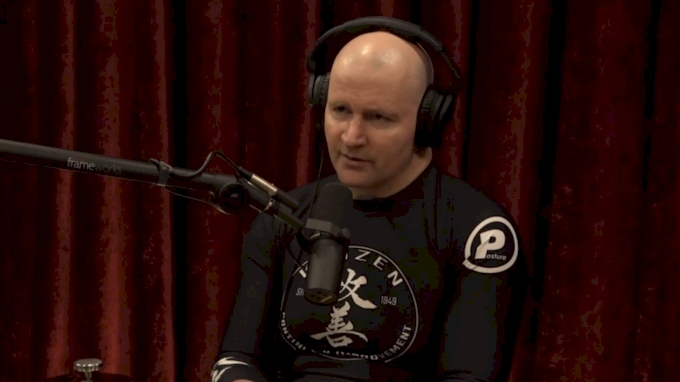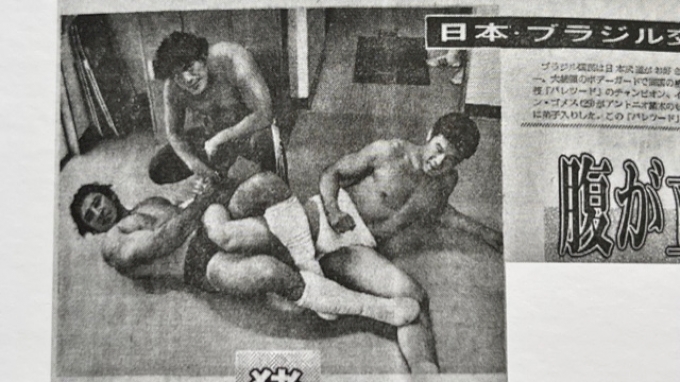The History of Heel Hooks
The History of Heel Hooks
Where did heel hooks originate, and how did they become so popular?

If you haven’t yet seen the most recent episode of the Joe Rogan podcast with John Danaher, download it and listen to it immediately after you’ve read this article. It’s an incredible insightful and interesting three-hour conversation that ranges from John’s coaching methods and thoughts on the growth of professional jiu-jitsu to Gordon’s medical issues and much, much more.

One of the standout moments of the interview was when Rogan asked Danaher about the origin of the heel hook, to which John could not offer a concrete answer. In modern times the heel hook is a staple move in submission grappling and no-gi jiu-jitsu, but it wasn’t always this way. Exactly how the technique came to be is unclear due to a lack of evidence, with Danaher saying he had heard a number of stories but could not verify any of them.
So Where Do Heel Hooks Come From?
Heel hooks are often attributed to catch wrestling or sambo. The history of catch wrestling is murky at best: inconsistent reporting has been mixed with myth, and so stories from the early 20th century are difficult to confirm. One thing that is known is that heel hooks did not originally come from Russian sambo – while modern sambo practitioners are often well-versed in the heel hook game this is a recent development and the international competition rules of sambo only permit straight leg attacks such as ankle locks and kneebars.
It is possible that heel hooks of some kind were present in jiu-jitsu but again, there is no evidence to support this theory. We can say that heel hooks were not known to be present in judo– there are no photos or videos showing twisting leg attacks in judo, although some texts and films highlight reaping ankle locks, calf crushes and Boston crab-style attacks as illegal techniques not permitted in practice or competition.
There is no solid evidence of them being used in Brazilian jiu-jitsu until the 1990s. That’s not to say heel hooks did not exist, but it is nearly impossible to find photos or video prior to this of anything but straight ankle locks being used by jiu-jitsu stylists.
Ivan Gomes and Brazilian Catch Wrestling
A common story is that touring catch wrestlers brought leg locks to Brazil, introducing them to local grapplers. It is a popular theory (albeit one nearly impossible to verify) that heel hooks originated in catch wrestling. This may be the case, but we do know and can confirm that they were utilized by Brazilian grapplers prior to jiu-jitsu becoming known overseas thanks to Ivan Gomes.
Ivan Gomes was a prominent Brazilian vale tudo fighter and pro wrestler active from the 1950s to 1970s. A formidable fighter with a background in judo, lute livre and jiu-jitsu, Gomes was a former opponent and later a friend of Carlson Gracie and is known to have trained with him. Antonio Inoki, a pivotal figure in the history of professional wrestling in Japan, was responsible for bringing Gomes to work in Japan in the mid-70s. There is a little-known photo in a Japanese publication, dated 1975 or 76, of Gomes demonstrating the heel hook with Inoki close by.

Gomes pictured in 1975/76 demonstrating a heel hook
It cannot be said he was the first person to introduce the heel hook to the Japanese wrestlers, but this exchange of information appears to have had a considerable effect on the grappling techniques as applied by the Japanese from this point on. Inoki would go on to train dozens of wrestlers, two of whom later founded the proto-MMA event Pancrase in 1993.
Leglocks in MMA and ADCC
The Japanese were among the pioneers of the leg lock game. The earliest recorded heel hook in a Japanese MMA event was when Yuki Nakai submitted Masakazu Kuramochi on June 24, 1993. It wasn’t long before we saw another heel hook in a Japanese MMA event. Pancrase was founded by a number of pro wrestlers trained by Inoki and they held their first event in September 1993. In the main event was Ken Shamrock, who was working as a pro wrestler in Japan at the time. A month later at Pancrase 2 on October 14, 1993, Shamrock defeated Kazuo Takahashi with a heel hook. Shortly after, Shamrock brought the move back to the USA when he submitted Patrick Smith at the first ever UFC on November 12, 1993.
The next person to score a heel hook in the UFC was Marco Ruas, a lute livre stylist from Rio de Janeiro, when he submitted Larry Cureton on September 8, 1995 at UFC 7. He was the first prominent Brazilian grappler to score a win via heel hook on the international scene. Heel hooks weren’t seen again in the UFC until 12 years when Christian Wellisch submitted Scott Junk in 2007 at UFC 76.
The first heel hook scored in a major no-gi submission grappling event was in 1998 at the inaugural ADCC, when Australian grappler Elvis Sinosic tapped out Clarence Thatch of the USA.
MMA fighter and ADCC champion Dean Lister is credited as convincing John Danaher about the effectiveness of leg attacks. Lister scored his first heel hook submission in MMA back in September of 2001, and remained one of grappling’s preeminent leg lockers for a generation, scoring no less than nine heel hooks in five ADCC tournament appearances (2003, 2009, 2011, 2013 and 2015).
Truthfully it is nearly impossible to trace the origins back further than the period where Gomes showed them to Inoki and the Japanese pro wrestlers. Grappling history unfortunately lacks many primary sources, and so we are left with incomplete or inaccurate stories that were passed down from generation to generation.
Despite the lack of credible history surrounding heel hooks, the modern era of jiu-jitsu has showcased the effectiveness of this popular technique, now a staple in any no-gi grappler’s toolbox. And we have Danaher to thank for much of that.